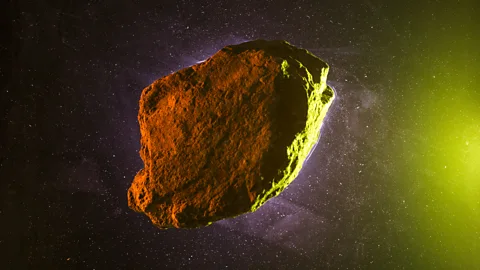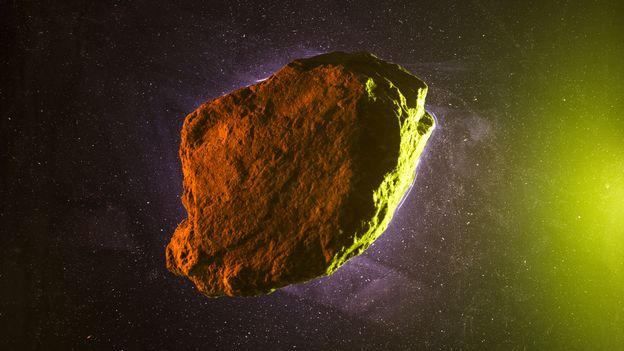 Getty Images
Getty ImagesThirty years ago the seminal BBC science programme Tomorrow’s World made a few predictions about how the world might be by 2025. It was a testament to how hard predicting the technological future is: we would, the programme suggested, have microchip implants to help us deal with ATMs, chat with holographic helpmates in our homes and there would be riots over internet access.
The founder of the California-based company AstroForge believes it will be the first to get there, and the company has already taken the first tentative steps. On 27 February 2025 it launched its first $6.5m (£5.1m) unmanned spacecraft on a SpaceX Falcon 9 rocket from the Kennedy Space Center in Florida. Around nine days later, AstroForge believes the spacecraft – named Odin – likely passed beyond the Moon and into deep space as planned.
Unfortunately, however, AstroForge developed major communications problems with Odin, which it is still trying to rectify at the time of writing. The firm hopes Odin has now entered its nine-month long coast to its mission destination: a fly-by of the carefully pre-selected asteroid 2022 OB5, some eight million km (five million miles) from Earth, which Odin will assess the composition of using its sensors.
“Move fast and break rocks” might be the mantra of Matt Gialich, AstroForge’s ebullient founder with a penchant for swear words, who is not dissuaded by the perhaps unresolvable technical trouble. AstroForge expected nothing less than many hurdles and has, he says, learned much even if contact isn’t made with this spacecraft again. “Yes, there are a lot more baby steps to take,” he concedes. “But we’re going to start to actually do it. You have to try.”
But others question whether mining these metals in space and bringing them back to Earth is really feasible, especially in the near term – and whether it could have its own unique, but just as impactful, environmental costs.
 SpaceX
SpaceXGialich hopes that over subsequent test launches over the next decade, AstroForge will recover small quantities of metal – initially a few grams, working up to kilograms as its programme advances – from target asteroids of a few metres to half a kilometre in diameter. Early hauls would likely not be commercial but, Gialich says, depending on the metals extracted, could take them on the way to commercialisation. Just one kilogram of rhodium, for example, is currently priced at $183,000 (£141,000).
It certainly sounds optimistic. But Victor Vescovo – one of the firm’s main investors and the explorer who built a submersible that in 2019 made him the first person to visit the bottom of all five oceans – feels that the technical challenges are “just a question of developing the tools”.
“Bring back a few micrograms to show it can be done and then scaling the process up is relatively straightforward,” he says. “To fully realise asteroid mining may be a multi-decade project. But it’s just a mathematical problem.” While it’s no doubt a major engineering feat to pull off, he adds, taking samples of material direct from asteroids has already been done by state space agencies, including Japan’s Jaxa with Hayabusa 1 and 2 back in 2005 and 2014, and NASA with its Osiris-Rex mission in 2020.
Ian Lange, associate professor at the Colorado School of Mines, an engineering research institution with a space resource programme, stresses that we can currently only estimate the technological hurdles of asteroid mining. A spacecraft rendezvousing with an asteroid may be only marginally more complicated than doing so with another spacecraft, he notes. But how, for example, might resources be extracted without the stabilising force of gravity?
“Mining – separating ore from dirt – is relatively straightforward, but then some kind of chemical or heat process, and gravity, is required to separate what we want from what we don’t,” Lange says. “Reproducing that in space is going to be much harder. At this stage it’s hard to say whether [established] techniques can be employed or whether [the asteroid mining industry] will have to develop entirely new ones.”
The idea of asteroid mining was largely the stuff of academic interest until the 1980s, when Nasa began to formulate ideas of just how space resources might be gathered, says Lange. These ideas gathered pace with growing environmental concerns during the 1990s, he adds. Indeed, since then several private companies the likes of Moon Express, Planetary Resources or Deep Space Industries struggled against the high development costs. By the end of the 2010s, the latter two were acquired and directed towards other projects. Small wonder Lange believes the combination of business and technological challenges means that asteroid mining is still another 30 years away.
The real game-changer, argues Vescovo, has been the technological pace of change over the last 10 years. New observatories, such as the nearly complete Vera C Rubin Observatory in Chile, will soon offer better tracking of asteroids. Optics and spectrographic analysis are affording easier identification of those that look to be candidates for mining – even if quite how many of these there are remains open to debate. Powerful computing has become more widely available. And there are more, and more affordable, off-the-shelf components with which spacecraft can be built.
“It wasn’t long ago that only governments could do this kind of thing or had access to the technology, and they never used it with much efficiency,” says Joel Sercel, founder of TransAstra, a Los-Angeles-based company developing various technologies for the fledgling asteroid mining sector. TransAstra will be running a demonstration of its inflatable “capture bag” tech for the collection of orbital debris on the International Space Station later this year. “Now we have a vibrant private space business that’s going to make asteroid mining happen vastly sooner than people predict.”
The most crucial development for asteroid mining is that it has become far easier and cheaper than ever to get a payload into orbit, due to the privatisation of the space industry and its development of reusable rockets.
“We’ve gone from it costing $10,000 (£7,850) to put 1lb (450g) into space 15 years ago, to a few thousand now,” says Vescovo. “And with the likes of Space X’s Starship the prospect of it costing hundreds of dollars in the near future.”
Lange, however, is sceptical of AstroForge’s plans: yes, asteroid mining will likely prove technologically possible, he reckons, but he is much less certain about Astroforge’s platinum group-focussed business model. “While Earth remains rich in [these resources], even if at the bottom of the sea, that still means a tonne of possibilities [to attain them] that are certainly easier than collecting them from space,” he says. “If, that is, we allow ourselves to take them.”
 AstroForge
AstroForgeBut Kathryn Miller, an environmental scientist at the University of Lancaster argues that asteroid mining could make for an environmentally more attractive option than, say, deep-sea mining – the still theoretical but soon to be regulated proposal to scrape the seabed for resources. While terrestrial mining is also “[not] exactly good…given the habitat destruction, the social justice issues and so on… gathering the nodules of cobalt and copper from the seafloor isn’t just a matter of removing the substrate, but destroying the seabed,” Miller says.
Of course, getting rockets into space and back is highly polluting and energy intensive but then so is mining. A 2018 study from researchers at the University of Paris–Saclay compared mining platinum on Earth to a projection of mining it from asteroids. The researchers estimated that 150kg of CO2 would be emitted into the Earth’s atmosphere for each kilogram of platinum mined from an asteroid. Producing 1kg of platinum on Earth using current practices, meanwhile, generates 40,000kg. This is essentially down to their rarity on Earth: the Earth’s upper crust is only 0.0005 parts per million platinum, with even the most productive mines currently operating at around five to 15 parts per million.
Daynan Crull, the founder of asteroid mining company Karmen+, thinks the future of asteroid mining lies more realistically in the search for resources to build an economy in space. The World Economic Forum predicts the space economy will be worth a staggering $1.8 trillion (£1.4 trillion) by 2035.
Mining in space could shift the balance of power between often developing nations naturally rich in minerals and developed ones able to harness the technology required to harvest them in space, argues Deganit Paikowsky, a scholar at George Washington University Space Policy Institute who researches the politics of space mining. Deganit is wary of the potential disruption to the status quo that asteroid mining might bring.
“It’s one thing to mine resources in space for use in space – look at the leading space-faring nations now and they’re more about creating an enduring human presence in space, so exploiting materials to that end is logical,” she says. “But it’s another thing to bring those resources back to Earth for use in an [established] Earth economy. That’s going to impact many different stakeholders in many ways.”
When it comes to asteroid mining, says Crull, the headline grabbers tend to be platinum group metals, along with other resources that might be mined, such as rare earths and the helium-3 required for nuclear fusion. But, he says, consider mining of water for its life-sustaining oxygen and rocket propellant hydrogen, or of clay for the 3D printing of ceramics that can be used to make, say, space habitats or solar collectors. Mining would circumvent much of the costs of getting these into space from Earth entirely.
“We looked at bringing asteroid resources back to Earth but the feasibility and economics seem fuzzy to us,” says Crull. Instead, Karmen+ is looking to mine resources in space to then be used in space, for making space habitats or in the maintenance of satellites, for example. Karmen+ has recently raised $20m (£15.4m) institutional investment and has a launch for its first spacecraft – to test sampling capabilities – booked for February 2027.
 AstroForge
AstroForgeGialich, however, argues that the resources in space should instead be viewed as a way to protect those on Earth. “There’s infinite space out there and countless asteroids but only one Earth,” he says.
There’s one more question that needs answered, though, before we start buying asteroid resources mined by these companies here Earth: are they really theirs to sell? That is some way off being decided, says Rosanna Deplano, a professor of international space law at the University of Leicester in the UK and an advisor to the Asteroid Mining Corporation, a London-based space mining company.
The 1967 Outer Space Treaty, the oldest but most widely ratified agreement on international space law – signed by 115 countries – says we should treat space as a commons but makes no reference to its resources. “So that implies [mining is] not forbidden,” says Deplano.
The 1979 Moon Agreement, meanwhile, says that the Moon’s natural resources shouldn’t become anyone’s property – but that has only been ratified by seven states, including Chile, the Netherlands and Morocco, and none of which to date have their own manned spaceflight programmes. A United Nations special committee is set to convene in 2027 to discuss the utilisation of space resources, but any pronouncement won’t be legally-binding.
Indeed, as indicated by discussions between the US and Ukraine on a potential deal over Ukraine’s mineral resources, it may be that national interests could take precedence. “If the extraction from asteroids is for scientific research I don’t think it will be terribly problematic,” says Deplano. “But the problem arises on the political level when it’s commercial.”
Countries are already giving interpretations on this issue from their own national perspectives, she adds. “That’s only incentivising commercialisation. It’s going to happen.”


